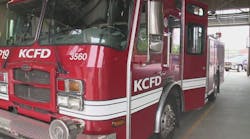Jan. 09--The silo fire that firefighters and farmworkers battled Monday started and was left to burn Sunday night, owners of the farm said Tuesday.
Dillon T. Murrock, 20, discovered the fire at 24658 Route 283, town of Pamelia, Sunday and alerted his father, Darryl T. The senior Mr. Murrock decided to address the problem in the morning because it could be unsafe for firefighters to combat the fire in the darkness.
When the sun rose Monday morning, a plume of smoke issuing from two small vents on the top of the silo -- used to circulate air -- was evidence that it was smoldering. When volunteer firefighters from the Northpole Fire Company arrived at 9:30 a.m., they took about a half hour to decide how to address the problem safely, Fire Chief Joseph A. Wargo said. Photos taken with a thermal imaging camera indicated the fire was concentrated at the bottom of the silo near the feed barn, where it likely started.
Firefighters determined the heat already had spread throughout the soybeans in the silo, which was about two-thirds full; a thermal image showed the heat had risen and concentrated near the top. The best approach, firefighters decided, would be to cut a large hole from the exterior of the silo to empty the soybeans.
"The idea was to see if there was anything left to salvage, because the heat had permeated through a good amount of the silo," Mr. Wargo said. They decided not to empty soybeans using the door in the feed barn, he said, for fear of starting a barn fire or putting firefighters or farmworkers in danger.
A saw was used to cut through the quarter-inch steel exterior, Mr. Wargo said, carving a large window 6 feet wide and 2 1/2 feet high. Small cuts also were made at the opposite side of the silo, and the top, to control the pressure inside the silo before the large hole was fully opened. Most of the soybeans that funneled out of the silo through the hole were burned. After several loads were scooped out by a tractor to empty the silo, the crew of about 15 firefighters finished the job by 2 p.m.
Though the precise cause of the fire was not determined, Mr. Murrock said he's fairly sure it wasn't caused by spontaneous combustion of the soybeans. Instead, the fire likely was started by the unusually high amount of tiny weed seeds -- mostly ragweed -- that were mixed with beans when they were harvested in the fall. When the soybeans were roasted at a high temperature in November before being stored in the silo, he said, the weed seeds probably retained much of the heat from that process when they entered the silo.
"When you put hot beans in there, you have to cool them down," he said. "But there could have been a pocket of these weed seeds in the center that smoldered and gained heat over time. The weed seeds could have created a dead spot where they heated up."
Spontaneous combustion of the beans wasn't likely, he said, because they had a moisture content of about 10 percent when they were roasted and stored in November, a level too low to spontaneously combust.
On Tuesday, workers at Murrock Farms spent the day separating soybeans that might still be used for cattle feed. Mr. Murrock said about 60 tons of soybeans could be salvaged, unless the cows don't like them because of the unpleasant taste. He said the organic beans are valued at $900 to $1,000 a ton. He now will have to purchase at least 120 tons of soybeans, which might be paid for partially by insurance.
Copyright 2013 - Watertown Daily Times, N.Y.





